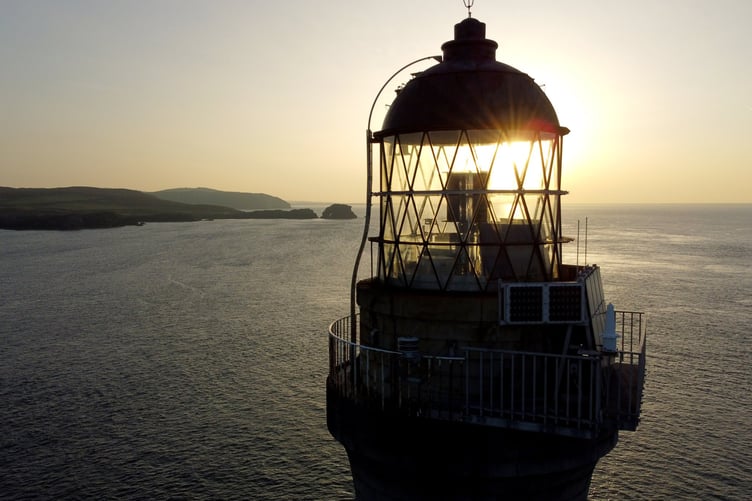One of the island’s best-known landmarks is to celebrate its 150th birthday later this year. Retired master mariner Dermot O’Toole details the history of Chicken Rock lighthouse.
Guardian of the Manx coastline, the Chicken Rock Lighthouse will soon be celebrating its 150th birthday.
On a direct route between the north-western ports of England and Wales and the eastern ports of Northern Ireland, these relatively shallow waters, only 40 metres in depth, are easily whipped up by high winds and tidal shifts, leaving the mariner dangerously exposed.
When the tide does turn, this is one stretch of coastline to be avoided.
By the beginning of the 19th century, the burgeoning levels of commerce in Britain had dramatically expanded to such an extent that ship owners on the Clyde, in Liverpool and Whitehaven began campaigning for improved safety aids in the Irish Sea.
In the spring of 1815, a petition signed by persons connected with the maritime trade of Liverpool encouraged the Commissioners of Northern Lighthouses to make an application for the erection of two lighthouse stations in the Isle of Man, both to be funded by favourable ‘light dues’ levied on commercial ships passing each light.
But the proposals put forward by the commissioners to erect lighthouses in the island were challenged by the Corporation of the Trinity House, who as the regulatory lighthouse authority for England and Wales, with exclusive rights to erect lighthouses upon such shores, considered it to be an encroachment on their chartered rights and resolved to oppose the Bill during its passage through parliament.
Nevertheless, after considerable parliamentary debate, and desirous of avoiding any interference with the arrangements of the commissioners, the Trinity House withdrew their offer to erect lighthouses in the Isle of Man, concluding that it was ‘extremely doubtful’ whether the island lay within the limits entrusted to them by an Act passed during the reign of Queen Elizabeth I and subsequent charters.
This left the way open for the commissioners to erect two lighthouse stations, one at the northern, and the other at the southern extremity of the Isle of Man at a cost of no more than £10,000.
Entrusted with this bold enterprise, with both stations completed in 1818, Robert Stevenson had cleverly configured the two lighthouses on the Calf of Man as leading lights, each lit by oil and furnished with a distinct, reflecting and revolving apparatus driven by a clockwork mechanism. Built 560 feet apart, the lower light elevated 282 feet above mean high water, the upper light 375 feet, both appeared as one when viewed from the sea on a north-easterly bearing.
This method of guarding the danger of the Chicken Rock, a dangerous outcrop of rocks one mile to the south-west, had to be adopted, as the borrowing powers conferred by an act of parliament were inadequate to the building of a tower on the rock itself.
But doubt was soon cast on the ability of the Calf Lights to fulfil the requirements for which they were designed.
From their lofty position on the highest part of the Calf of Man, the lights were often obscured by prevailing fog, their ineffectiveness leading to calls by the mercantile interests of England Scotland and Ireland for the lights to be extinguished and replaced by a light upon the Chicken Rock.
As a consequence of at least 70 shipwrecks, occasioning the loss of 160 lives on the southern shores of the Isle of Man during the years 1822-1867, arrangements were made by the commissioners of Northern Lighthouses for their engineers to inspect the Chicken Rock and to form a judgement as to its viability and cost of the work. In their preliminary report dated October 22, 1867, Messrs. Stevenson wrote: ‘Exposed in a tideway of significant strength, the rock measures about 200 feet in length, its breadth varying from about 130 feet to about 65 feet and rises from deep water to about three feet above the level of high water of ordinary springs when only the merest patch is to be seen.
‘The construction of a lighthouse upon it, though not attended with such disadvantages as regards situation and exposure as beset the work now in progress at Dhu Heartach, will nevertheless be one of “no ordinary magnitude” and attended with formidable difficulty and expense. Other than the above mentioned, there seems to be no engineering obstacle to the work being carried to a successful conclusion and we are of opinion that the work should be undertaken.’
Deceptively simple but endlessly complicated, the arrangements necessary for building a rock lighthouse are immense.
Labour intensive, time-consuming, extremely expensive and dangerous to erect, four years or more were normally required to complete this Herculean task at the very limit of technology.
Like all previous rock lighthouses designed and built by the Stevensons, the Chicken Rock Lighthouse would have to withstand the harshest environment any structure could face.
Imported from the granite quarries of Dalbeattie, Scotland, the stone used in construction of the tower had to be strong enough to withstand the destructive force of the Irish Sea, but soft enough to be cut.
Due to its isolation, severe tidal restraints and limited working area, cutting, shaping and dressing the stone on the Chicken Rock itself was impossible.
Accordingly, the fishing village of Port St Mary, five miles distant, was selected as the site of the work yard. A tramway was laid down for transportation of stone to and from the harbour and a suitable steamer sourced to act as a tender and floating barrack capable of accommodating 50 men if weather or tidal conditions disrupted work.
The first landing of a small party of workmen on the Chicken Rock was made on April 29, 1869. With the reef nearly covered at high water and exposed to the full fetch of the Irish Sea, work was difficult and slow. Fighting a constant battle against the rising tide, the stone masons shaped the 42-foot diameter foundation pit to the curve of the tower using little more than pickaxes and shovels.
It was a backbreaking task that tested man to the limit and took a whole summer to complete.
Meanwhile, Port St Mary had assumed a livelier aspect than usual. Vessels deeply laden with stone were arriving in the harbour, while immense travelling steam cranes made easy work of their discharge.
From 1869 to 1873, the work yard was a busy place with no fewer than 80 men employed in various capacities. Chiselled into shape, marked and numbered in the correct sequence for assembly, the granite blocks, some weighing upwards of two and a half tons, were shipped in lighters to their destination four and a half miles distant.
Work on the tower was carried out during the summer months when weather and tidal conditions permitted, sometimes not an hour, and at other times six or seven. When the weather was poor, the men spent nearly as long commuting to and from the Rock as they did at work.
The working season extended from April to September, the number of men employed averaged about 35. Being a tidal rock and nearly covered at high water, it afforded no opportunity for storing materials, and consequently, only those blocks that could be laid between tides were landed.
The spring of 1870 was very stormy, and the workmen were long detained in erecting the three cranes placed on the rock to discharge and build the material. During the season, nine of the 94 courses constituting the tower were built on the rock and bolted, cramped, and joggled into position prior to the work being suspended for the winter.
The following year, 1871, a balance crane was added, however up to this time all the work had been done by manual labour. Steam now came to the workman’s assistance and another 14 courses were added – in all, 23 from the foundation pit to the entrance door. Like its twin under construction on Dhu Artach Skerry, the tower thus far was solid to the entrance door and stood 33 feet four inches above its foundation.
The fourth season, 1872, saw the introduction of a powerful steam crane and the addition of 47 courses. The tower advanced rapidly, a circumstance in great measure due to the assistance derived from steam in raising and positioning the stones.
The fifth season, 1873 saw the 96th course, the last, landed and fixed on June 6.
By the end of the season the joiners and others were ready to put up their fittings, and following this, the tower was constantly occupied by tradesmen until the end of August 1874.
A scheme long in the gestation and hazardous in the construction, the completion of this magnificent monument of architectural skill and human ingenuity in December 1874 was acknowledged as a masterclass in meticulous planning and engineering precision.
As architects of the Chicken Rock Lighthouse, the great merit due to the Stevensons lay in their bold conception of, and confident unshaken belief, in the possibility of erecting a tower of masonry, whose base being left dry only at very low water tides and covered at periods of high water to the depth of three feet, obviously presented much greater difficulty than previous enterprises.
With seven compartments and walls 9 feet 6 inches thick at the entrance door, the Chicken Rock Lighthouse as finished may be described as a magnificent pale-grey granite column rising to a height of 143 feet above its base. Containing 49,000 cubic feet of masonry, weighing 3,650 tons and erected at a total cost of £65,133, it is the second tallest and last of the great towers built by the Stevenson dynasty.
Commissioned on January 1 1875, with a revolving white light flashing once every half-minute and visible for 16 nautical miles, the Chicken Rock Lighthouse suffered a disastrous fire in December 1960, forcing the three lightkeepers to escape from the blazing inferno by descending 120 feet from the balcony to the rock below by means of a safety rope kept in the lightroom.
Automated in 1961, put back into service with propane gas substituted for oil as the main source of illuminant, the future of the Chicken Rock Lighthouse remained far from certain.
In 1968, a new ‘state of the art’ lighthouse was built on the Calf of Man as a future replacement for its offshore neighbour, now de-rated as a minor light with a reduced range of 13 miles. Despite sumptuous accommodation for its four lightkeepers, a workshop and the most powerful ray of light ever to probe the darkest waters of the Irish Sea, the Calf of Man station enjoyed a relatively short lifespan of less than four decades. Automated in 1995 and the lightkeepers stood down, advancing technology in 2007 made the facility redundant.
Meanwhile, the Chicken Rock Lighthouse was about to enjoy a new lease of life. Significantly upgraded in 1999, with solar power replacing propane gas as the primary means of electrification, the light underwent further improvements in 2007 with a more powerful white light, flashing once every five seconds and visible for 21 miles.
Today, the Chicken lighthouse stands as a glorious tribute to the men who built it. The lightkeepers and their families may have gone, but this shining example of Victorian architecture remains a monument that has long outlived its creators, thus proving the old fishermen of Port St Mary wrong when they prophesied it was an undertaking doomed to failure from its very beginning.

.jpg?width=209&height=140&crop=209:145,smart&quality=75)

-(1).jpeg?width=209&height=140&crop=209:145,smart&quality=75)

Comments
This article has no comments yet. Be the first to leave a comment.